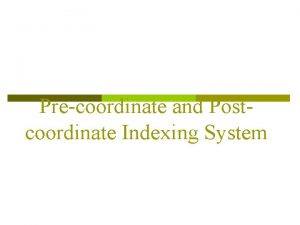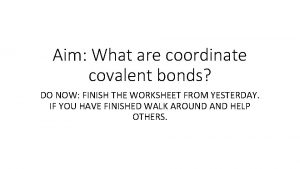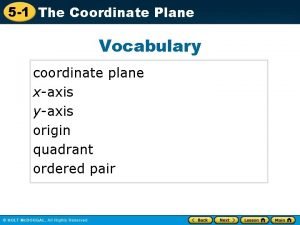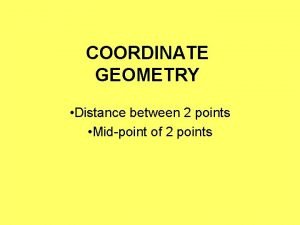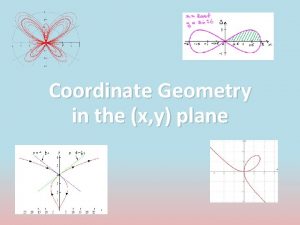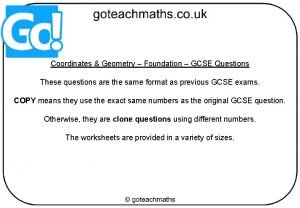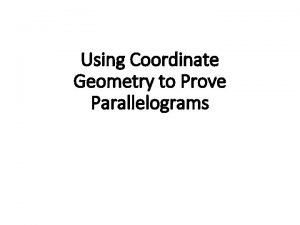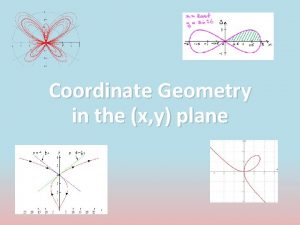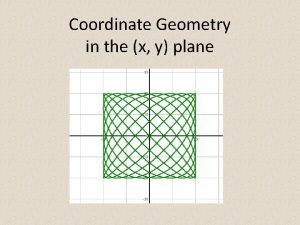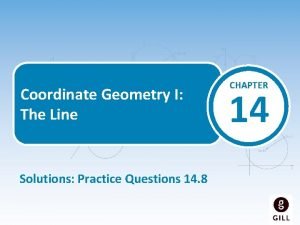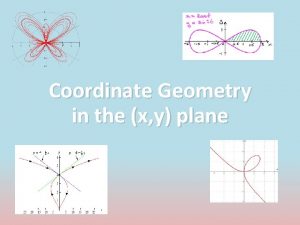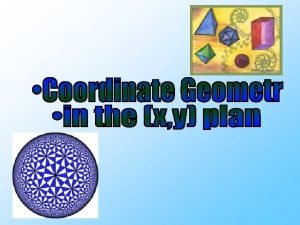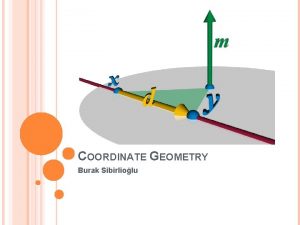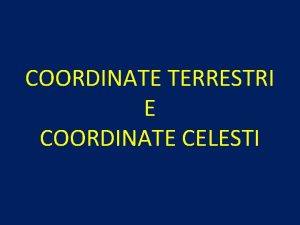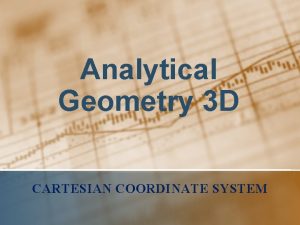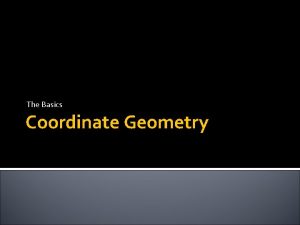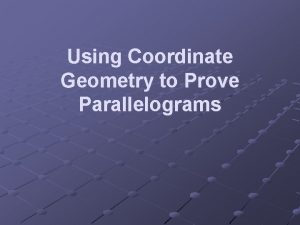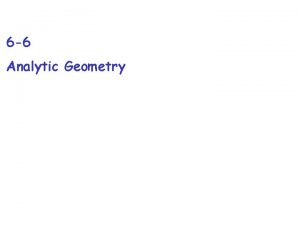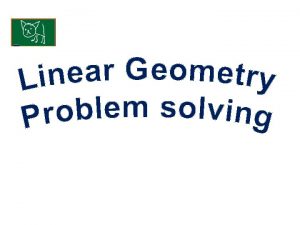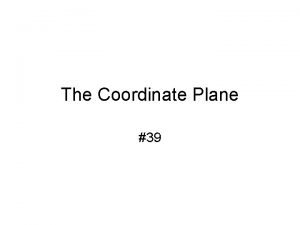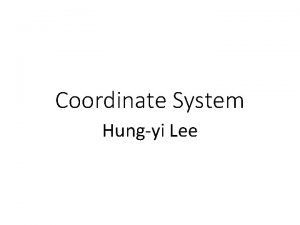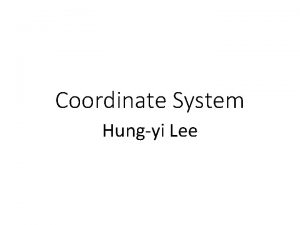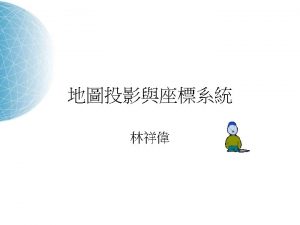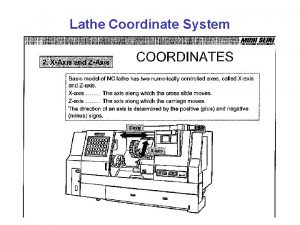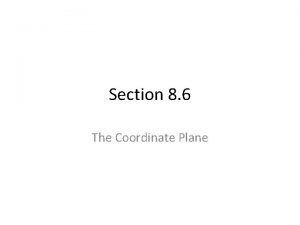Teaching Geometry for Understanding Coordinate Geometry postprimarymathspdst ie






























- Slides: 30

Teaching Geometry for Understanding: Coordinate Geometry postprimarymaths@pdst. ie @Project. Maths_ie

Resources https: //www. scoilnet. ie/pdst/maths/ @Project. Maths_ie 2

Key Messages Teaching Geometry in an integrated way deepens students’ understanding. Constructivism provides rich learning experiences and promotes problem solving skills, through students working together to develop their own understanding of Mathematics. It is important to build on students’ prior knowledge from Junior Cycle to extend their learning at Senior Cycle. 3

Learning Outcomes By the end of this workshop participants will have: ● explored that allowing students to engage with rich open tasks will encourage all students to become more confident in their mathematical ability, develop their critical-thinking skills and will provide them with the tools needed to attempt unseen problems. ● discussed the importance of their students engaging with geometry as one coherent topic. ● considered the value of effective collaboration. 4

Looking at International Comparison Studies Consider the evidence from the international comparison studies on the handouts. What does this say about our students current understanding of Geometry? 5 5

The van Hiele Theory of Geometric Thought What are the key elements of the van Hiele Theory? How do they inform our practice in light of the evidence presented? 6

How would your students approach this question? The points A(-9, 3), B(-4, 3) and C(-4, 10) are the vertices of the triangle ABC. Find the area of the triangle ABC. What are the implications of the approaches taken to tackling this problem? 7

8

Visualise the problem 2014 Paper 2 OL Q 4 9

Unit of Work: The Area Of A Triangle 10

An Integrated Approach 11

Prior Knowledge Plotting cartesian points on a cartesian plane Properties of congruent triangles Constructions of triangles given SSS, SAS, ASA or RHS data Recognise images of points and objects under a given translation Area of regular 2 dimensional shapes and composite shapes made from a combination of these If two lines are parallel then a transversal makes two equal alternate angles on the two lines (Theorem 3 Converse) 12

Unit of Work: Area of Triangles Lesson 1 3 Axiom 4, Congruent triangles Identifying the properties of congruent triangles. SSS, SAS, ASA, RHS Construction 10 Triangle given the lengths of 3 sides Construction 11 Triangle given SAS data Construction 12 Triangle given ASA data Construction 13 Right angled triangle, given length of hypotenuse and one other side Construction 14 Right angled triangle, given one side and one acute angle Inquiry based activity on the area of a right-angled triangle 4 Inquiry based activity on the area of non right angled triangles 5 Deduction of Theorem 9, corollary 1: A diagonal divides a parallelogram into two congruent triangles Deduction of Theorem 17: The diagonal of a parallelogram bisects the area 6 Application of learning from the inquiry based activities 7 Transformation geometry. Inquiry based activity on translation of shapes and coordinate points in a Cartesian plane. Use of Geo. Gebra 8 Calculate the area of a triangle using trigonometry. Inquiry based activity. 2 13 Description of the Content

Lesson 4 Use the geoboards to construct the following scalene triangles : 1. All angles acute and one side vertical 2. All angles acute and no vertical or horizontal sides 3. An obtuse angle and no vertical or horizontal sides 16

Breakout Room : Jamboard Activity How can you determine the area of the triangle in each case? Summarise what you have learnt. General Statement Link to jamboard 17

Poster 19

Application of learning Hence find the area of a triangle with vertices (-3, 4) (4, 2) (6, 10). 20

Student Reflection Review and summarise what you have learnt about the area of a triangle through these activities. Consider what new thinking has replaced your previous level of thinking. Link to padlet 21 QR Code for padlet

Student Reflection Feedback 22

Teacher Feedback Compare and contrast this approach with those recorded at the beginning of the workshop. How will this approach translate into the classroom? 23

Putting Learning into Action: Gathering the Branches of Geometree? 24

Reviewing the unit of work Lesson Description of the Content 1 3 Axiom 4, Congruent triangles Identifying the properties of congruent triangles. SSS, SAS, ASA, RHS Construction 10 Triangle given the lengths of 3 sides Construction 11 Triangle given SAS data Construction 12 Triangle given ASA data Construction 13 Right angled triangle, given length of hypotenuse and one other side Construction 14 Right angled triangle, given one side and one acute angle Inquiry based activity on the area of a right-angled triangle 4 Inquiry based activity on the area of non right angled triangles 5 Deduction of Theorem 9, corollary 1: A diagonal divides a parallelogram into two congruent triangles Deduction of Theorem 17: The diagonal of a parallelogram bisects the area 6 Application of learning from the inquiry based activities 7 Transformation geometry. Inquiry based activity on translation of shapes and coordinate points in a Cartesian plane. Use of Geo. Gebra 8 Calculate the area of a triangle using trigonometry. Inquiry based activity. 2 25 https: //tinyurl. com/Uo. WSample

Task: In your breakout room, your group will be given a Jamboard containing multiple concepts in geometry. Your task is to: - Outline a sequential unit of work including these topics. - Discuss and document your rationale. QR Code for padlet Link to Jamboard 26

Reflection 27

Highlight your Learning under the Following Headings ● Teaching Geometry in an integrated way deepens students’ understanding. ● Constructivism provides rich learning experiences based on student understanding and promotes problem solving skills. ● By engaging deeply with Geometry at Junior Cycle, students acquire the conceptual understanding and skills to understand Geometry at Senior Cycle. 28 QR Code for padlet

School Support Single Visit School Support : postprimarymaths@pdst. ie Sustained Support pdst. ie/schoolsupport 29 : @Project. Maths_ie

PDST Supports Seminars Webinars Professional Learning Communities Lesson Study 30 School Visits PDST Websites Single Visit Sustained Support pdst. ie scoilnet. ie projectmaths. ie

PDST Post Primary Maths Team Leader Stephen Gammell stephengammell@pdst. ie Advisors: Angela Dwane angeladwane@pdst. ie Enda Donnelly endadonnelly@pdst. ie Administrator Gráinne Haughney grainnehaughneymdt@pdst. ie Dympna Mc. Coy dympnamccoy@pdst. ie Warren Mc. Intyre warrenmcintyre@pdst. ie Arlene Murphy arlenemurphy@pdst. ie Michael Walsh michaelwalsh@pdst. ie Darren Murphy darrenmurphy@pdst. ie Twitter @Project. Maths_ie General Enquiries: Postprimarymaths@pdst. ie

Tan q 32

References ERC. (2015) TIMSS in Ireland: Mathematics and Science in primary and post-primary schools. ERC, (2012) Learning for Life: The Achievements of 15 -year-olds in Ireland on Mathematics, Reading Literacy and Science in PISA 2012 Fuys, D. , Geddes, D. , & Tischler, R. (1988). Journal for. Research in Mathematics Education Mono-graph 3: The van Hiele model of thinking in geometry among adolescents. Reston, VA: National. Council of Teachers of Mathematics. Crowley, M. L. (1987): The Van Hiele Model of the development of geometricthought, in N. C. T. M. (1987): Learning and teaching geometry, K-12. (N. C. T. M. : Reston, USA), pp. 1 -16. Newman, F. M. , Marks, H. M. , & Gamoran, A. (1996). Authentic Pedagogy and Student Performance. American Journal of Education, 104, 28 -312 Lubienski, Sarah & Stilwell, Jean. (2011). Teaching Low-SES Students Mathematics Through Problem Solving: Tough Issues, Promising Strategies and Lingering Dilemmas.
 Popsi indexing system
Popsi indexing system Meaning of coordinate bond
Meaning of coordinate bond Coordinate geometry vocabulary
Coordinate geometry vocabulary Length formula coordinate geometry
Length formula coordinate geometry Coordinate geometry in the (x y) plane
Coordinate geometry in the (x y) plane Coordinate geometry gcse
Coordinate geometry gcse How could you use coordinate geometry to prove that bc ad
How could you use coordinate geometry to prove that bc ad How could you use coordinate geometry to prove that bc ad
How could you use coordinate geometry to prove that bc ad Xyxy xy-plane
Xyxy xy-plane Coordinate geometry proofs
Coordinate geometry proofs Coordinate geometry in the (x y) plane
Coordinate geometry in the (x y) plane Coordinate geometry practice questions
Coordinate geometry practice questions Coordinate geometry in the (x y) plane
Coordinate geometry in the (x y) plane Coordinate geometry formula
Coordinate geometry formula Meaning of microteaching
Meaning of microteaching Mat för idrottare
Mat för idrottare Smärtskolan kunskap för livet
Smärtskolan kunskap för livet Bris för vuxna
Bris för vuxna Teckenspråk minoritetsspråk argument
Teckenspråk minoritetsspråk argument Ledarskapsteorier
Ledarskapsteorier Trög för kemist
Trög för kemist Indikation för kejsarsnitt på moderns önskan
Indikation för kejsarsnitt på moderns önskan Datorkunskap för nybörjare
Datorkunskap för nybörjare Steg för steg rita
Steg för steg rita Returpilarna
Returpilarna Redogör för vad psykologi är
Redogör för vad psykologi är Lek med former i förskolan
Lek med former i förskolan Claes martinsson
Claes martinsson Rap texter som rimmar
Rap texter som rimmar Nyckelkompetenser för livslångt lärande
Nyckelkompetenser för livslångt lärande Svenskt ramverk för digital samverkan
Svenskt ramverk för digital samverkan
